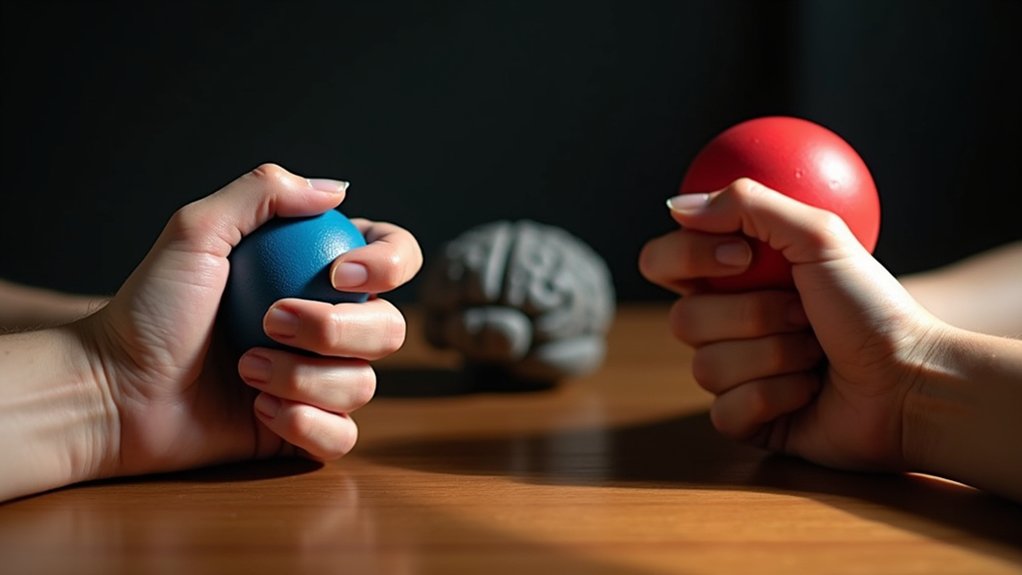Managing recovery cravings requires a multi-faceted, science-backed approach. You’ll find success through mindfulness practices that transform reactive responses, regular exercise that triggers natural feel-good chemicals, and cognitive restructuring to reframe negative thoughts. Build a strong support network, maintain consistent daily routines, and practice stress management techniques like deep breathing. Focus on proper nutrition with B vitamins and omega-3s to stabilize brain chemistry. These evidence-based methods form your extensive toolkit for lasting recovery.
Understanding the Science Behind Recovery Cravings

While recovery cravings can feel overwhelming and unpredictable, they’re rooted in specific neurobiological mechanisms that science has helped us understand. Recent neuroanatomy insights reveal how your brain’s ventral striatum drives craving intensity, while your dorsolateral prefrontal cortex works to control these impulses. Keeping track through daily journaling helps identify patterns in these neurological responses.
Your brain’s response to substance use involves complex dopamine dysregulation, where chronic exposure disrupts normal neurotransmitter function. When you encounter triggers or stress, your amygdala amplifies emotional responses, making cravings more intense. Meanwhile, your prefrontal cortex responsible for decision-making and impulse control may struggle to override these powerful signals. The reward system evolved as a survival mechanism to reinforce beneficial behaviors, which explains why breaking addiction patterns is particularly challenging. Understanding these mechanisms helps explain why you might experience stronger cravings during stress or when encountering environmental triggers, and why emotional regulation plays such an essential role in recovery. The presence of co-occurring mental disorders can significantly intensify these cravings and complicate the recovery process.
Mindful Awareness: A Powerful Tool for Craving Management
Understanding the neurobiological basis of cravings opens the door to powerful management strategies, with mindful awareness standing at the forefront. Through mindful observation, you’ll transform reactive craving responses into reflective choices, creating space between urges and actions. Present moment awareness helps create a healthier relationship with thoughts and emotions during recovery.
Craving awareness helps you recognize triggers without automatically reacting to them. You’ll learn to observe urges as temporary phenomena rather than overwhelming threats, while developing a compassionate, nonjudgmental stance toward your experiences. Studies show that loading working memory through mindfulness practices effectively diverts attention from craving-related thoughts. This approach strengthens your emotional regulation and decision-making abilities. Anxiety and depression significantly decrease when mindfulness practices are combined with medication-assisted treatment.
Research confirms that mindfulness-based programs effectively reduce relapse rates across various addiction types. When combined with traditional treatments like CBT, mindful awareness techniques enhance your recovery outcomes by rewiring neural pathways from reactive to reflective processing, building lasting resilience against cravings.
Physical Exercise as a Natural Craving Reducer

Exercise delivers a powerful one-two punch against cravings by flooding your brain with natural feel-good chemicals like endorphins and dopamine. You’ll find that even short bursts of physical activity can greatly reduce the intensity of immediate urges while activating the same reward pathways that substances once did. When cravings strike, you can turn to quick activities like a brisk walk or brief stretching session to help your brain naturally reset and resist the temptation. Aiming for thirty minutes daily of physical movement at least 4 times per week provides optimal benefits for recovery. Studies show that moderate-intensity exercise has demonstrated particular effectiveness in diminishing drug cravings and supporting recovery success. Regular aerobic activity serves as an affordable holistic treatment that addresses both physical and psychological aspects of addiction recovery.
Exercise Releases Feel-Good Chemicals
When your body engages in physical activity, it naturally produces a powerful cocktail of neurochemicals that can effectively counter addiction cravings. Exercise benefits include increased dopamine production, which strengthens neural connections and improves your cognitive function. During physical activity, your brain releases endorphins that create natural pain relief and feelings of euphoria. Studies show that aerobic exercises increase dopamine and receptor availability in the brain, helping to reduce drug-seeking behaviors. Setting up a consistent routine with 150 minutes weekly of moderate exercise provides optimal benefits for recovery. You’ll also experience improved chemical balance through the release of endocannabinoids, which reduce anxiety naturally, similar to the effects of marijuana but without harmful consequences. Regular exercise triggers mood enhancement through serotonin regulation, helping stabilize your emotional state and reduce substance cravings. This neurochemical response creates a sustainable, healthy alternative to substance use, as your brain’s reward pathways respond positively to physical activity instead of harmful substances. Physical activity serves as an essential adjunctive treatment method in comprehensive addiction recovery programs.
Quick Workouts Beat Urges
During intense craving episodes, engaging in quick, targeted workouts can provide immediate relief through both physiological and psychological mechanisms. When urges strike, you’ll find that just 20-30 minutes of moderate exercise can disrupt negative thought patterns and trigger beneficial brain chemistry changes. Understanding that cravings last 30 minutes makes exercise an ideal timing match for overcoming urges. A consistent exercise routine helps create reliable daily structure that supports long-term sobriety.
For effective urge management, keep workout gear ready and establish pre-planned routes for immediate action. You don’t need complex equipment, walking, bodyweight exercises, or a quick run can effectively reduce cravings. Quick workouts in outdoor settings prove particularly beneficial, as they remove you from triggering environments while enhancing mood improvements. Recent studies across multiple treatment centers show that inpatient exercise programs are increasingly incorporated as vital components of addiction recovery.
Studies show that moderate-to-vigorous activity yields the strongest results, especially for stimulant-related cravings. By responding to urges with immediate physical activity, you’re not just distracting yourself, you’re actively rewiring your brain’s response to cravings.
Building Your Personal Recovery Support Network
Building a robust support network stands as one of the most critical factors in maintaining long-term recovery success. Support group dynamics and peer accountability create a protective shield against relapse, with research showing a 7-25% reduction in relapse risk for active participants. You’ll find that connecting with others who’ve walked similar paths strengthens your recovery foundation.
Consider these proven ways to build your support system:
- Join weekly support meetings where you’ll develop meaningful friendships with others committed to sobriety
- Connect with a peer recovery coach who can offer real-world insights from their own recovery journey
- Participate in community recovery events to expand your sober social circle
- Engage family members and trusted friends in your recovery process through open communication
These connections will serve as essential anchors during challenging moments in your recovery journey. The evidence is clear 81% of participants report developing stronger personal support networks through regular group attendance.
Creating an Effective Relapse Prevention Strategy

A thorough relapse prevention strategy acts as your personalized roadmap for steering through recovery challenges. You’ll need to combine cognitive strategies with practical coping techniques to build a detailed defense against relapse triggers. Start by identifying your specific triggers and developing mindfulness practices to recognize early warning signs.
Incorporate cognitive restructuring to challenge substance-related thoughts while building alternative coping methods like creative expression and grounding exercises. You’ll want to establish clear emergency planning protocols for high-risk situations, including specific steps to take when cravings intensify. Additionally, focus on lifestyle changes that support your recovery from maintaining consistent sleep patterns to engaging in regular physical activity. Remember that stress awareness and proactive management through these various techniques will strengthen your relapse prevention foundation.
Stress Management Techniques That Work
Effective stress management serves as a cornerstone for maintaining lasting recovery and reducing the intensity of cravings. By implementing proven stress reduction techniques, you’ll build emotional resilience strategies that protect your recovery journey. Focus on creating an environment that supports your well-being while developing practical tools to handle daily pressures.
- Picture yourself taking slow, deep breaths in a quiet room, allowing tension to melt away as you exhale
- Envision setting firm boundaries with challenging people, like declining invitations that might trigger stress
- Visualize engaging in a favorite hobby, such as painting or gardening, while your mind settles into a peaceful state
- Imagine disconnecting from devices and spending time in nature, letting environmental stress fade into the background
Cognitive Restructuring for Long-Term Success
Restructuring your habitual thought patterns is essential for managing cravings and sustaining long-term recovery success. You’ll learn to identify and reframe negative self-talk through proven cognitive techniques that build resilience against triggering situations. By consistently practicing these mental defense tools, you’ll replace old, destructive thought scripts with balanced, recovery-oriented perspectives that support your healing journey.
Reframing Negative Thought Patterns
When negative thought patterns arise during recovery, cognitive restructuring serves as a powerful tool to transform distorted thinking into balanced, reality-based perspectives. Through thought awareness and cognitive reframing, you’ll learn to identify triggers, challenge distorted beliefs, and replace harmful thoughts with realistic affirmations. This process helps break the cycle of negative self-talk that often leads to cravings and potential relapse.
- Picture yourself as a detective, examining each thought with objective curiosity
- Envision your mind as a control room where you can adjust unhelpful thought patterns
- Imagine your negative thoughts as clouds that you can observe and let pass
- Visualize yourself building a mental toolkit filled with positive coping strategies
Focus on tracking your triggers and responses through structured reflection, while practicing mindfulness to stay grounded in the present moment.
Building Self-Talk Defense Tools
Building a robust self-talk defense system requires mastering specific cognitive tools that protect your recovery journey. When you develop cognitive flexibility through structured self-talk strategies, you’ll strengthen your ability to challenge and reframe triggering thoughts.
| Trigger Type | Negative Self-Talk | Defensive Response |
|---|---|---|
| Social Pressure | “I can’t say no” | “I choose my health first” |
| Stress | “I need substances to cope” | “I have healthier alternatives” |
| Isolation | “Using is my only comfort” | “I can reach out to support” |
| Past Guilt | “I’ll never change” | “I’m growing stronger daily” |
| Uncertainty | “Recovery is impossible” | “I’m succeeding step by step” |
Replacing Old Mental Scripts
To successfully reshape your recovery journey, old mental scripts must be systematically replaced with healthier thought patterns that support long-term sobriety. Through cognitive flexibility and structured thought replacement, you’ll develop mental resilience by evaluating existing beliefs and implementing new coping strategies. Narrative therapy techniques help transform limiting thoughts into empowering affirmations that reinforce your commitment to recovery.
- Replace “I need substances to cope” with “I have effective tools to manage stress”
- Transform “I’ll never stay sober” into “I’m building strength in recovery each day”
- Shift “I’m powerless against cravings” to “I choose healthy responses to triggers”
- Convert “Recovery is impossible” to “I’m capable of maintaining lasting sobriety”
Regular script evaluation and affirmations practice will strengthen your new mental framework, supporting sustained recovery progress.
Developing Healthy Coping Mechanisms
Developing healthy coping mechanisms serves as the cornerstone of sustainable addiction recovery. You’ll need to build emotional resilience through a combination of mindfulness practices and structured activities that replace destructive patterns with life-affirming behaviors.
Start by incorporating meditation and guided imagery into your daily routine to manage emotional triggers. These coping strategies help you observe cravings without judgment while strengthening your impulse control. Pay attention to HALT symptoms: hunger, anger, loneliness, and tiredness, as they often precede intense urges. When these warning signs emerge, engage in therapeutic activities like yoga or progressive relaxation exercises.
Document your triggers and responses in a coping journal, tracking both challenges and victories. This self-monitoring helps identify patterns while reinforcing your commitment to recovery through measurable progress.
The Role of Nutrition in Managing Cravings
Proper nutrition plays a fundamental role in managing addiction-related cravings by stabilizing both brain chemistry and emotional responses. By understanding nutrient timing and identifying craving triggers, you’ll strengthen your recovery journey through strategic dietary choices. Your brain’s reward pathways respond similarly to both processed foods and addictive substances, making nutrition optimization essential for managing cravings effectively.
- Choose vitamin B-rich foods to support dopamine production and mood regulation
- Incorporate omega-3 fatty acids from fish and nuts to reduce inflammation-driven cravings
- Maintain stable blood sugar with protein-rich meals and complex carbohydrates
- Stay hydrated with electrolyte-balanced beverages to minimize withdrawal symptoms
Focus on whole, unprocessed foods while avoiding refined sugars and preservatives that can cross-sensitize with addiction pathways. Working with a nutritionist can help you develop personalized meal plans that address your specific deficiencies and craving patterns.
Daily Routines and Lifestyle Adjustments for Recovery
Establishing consistent daily routines forms the foundation of your recovery journey, helping you navigate cravings and maintain long-term sobriety. You’ll want to start each morning with wellness activities like meditation, exercise, or journaling to set a positive tone for the day ahead. Your evening routine should include calming practices that promote restful sleep and prepare you for the next day’s challenges, such as setting out workout clothes, preparing healthy meals, or scheduling recovery meetings.
Structure Daily Recovery Routines
When recovering from addiction, structured daily routines serve as a crucial foundation for long-term success. You’ll need to establish clear structured activities while maintaining routine flexibility to accommodate life’s uncertainties. By prioritizing self-care practices and integrating mindfulness into your schedule, you’re creating powerful neural pathways that support recovery milestones.
- Start each morning with daily reflections and gentle stretching to center your mind
- Block your day into focused segments, including scheduled breaks for mental reset
- Dedicate specific times for fitness goals, whether it’s walking, yoga, or gym sessions
- End each evening with recovery-focused activities like journaling or meditation
Morning Wellness Activities
Successful morning wellness activities serve as the cornerstone of your recovery journey by creating a stable foundation for each day. Start with morning mindfulness practices like yoga, which combines physical movement with mental clarity to strengthen your resistance against triggers. By incorporating daily affirmations and structured routines, you’ll reduce decision fatigue and build emotional stability.
Focus on simple, consistent actions such as making your bed, practicing hygiene, or tending to a small garden. These activities provide both physical benefits and mental resilience while channeling your energy into productive tasks. You’ll find that maintaining a predictable environment through these morning rituals helps minimize impulsivity and reinforces your commitment to sobriety. These intentional habits replace destructive patterns and prepare you to navigate daily challenges with confidence.
Building Healthy Evening Habits
Building healthy evening habits forms the critical bridge between daytime stability and restorative sleep in your recovery journey. By establishing structured evenings and calming routines, you’ll create a protective buffer against nighttime triggers. Transform your bedroom into a soothing environment through mindful shifts and tech-free zones, allowing your mind to naturally wind down.
- Set up a dedicated journaling space with soft lighting and comfortable seating
- Create a relaxation corner with cushions, calming artwork, and gentle music
- Arrange an evening tea station with herbal options and mindfulness prompts
- Design a decluttered nightstand area for essential relaxation techniques
Incorporate gratitude exercises into your evening rituals, focusing on daily victories rather than challenges. You’ll find these intentional practices strengthen your recovery while fostering the peaceful mindset needed for restorative sleep.
Frequently Asked Questions
How Long Do Recovery Cravings Typically Last During Each Episode?
Your craving duration typically lasts anywhere from several minutes to a few hours during each episode. While you’ll notice these intense urges emerge quickly, they don’t last forever. Each individual’s experience varies based on their unique craving triggers, including environmental cues, stress levels, and emotional states. You’ll find that with proper coping strategies, the intensity and length of these episodes tend to diminish over time.
Can Medications Help Reduce the Intensity of Recovery Cravings?
Yes, medications can greatly reduce your craving intensity. Several medication types are specifically designed for craving management naltrexone blocks the rewarding effects of substances, while acamprosate helps restore your brain’s chemical balance. You’ll find that buprenorphine and methadone can effectively suppress opioid cravings. When combined with behavioral therapy, these medications don’t just diminish cravings they’ll help you maintain long-term recovery by addressing both physical and psychological aspects.
Are Cravings More Intense for Certain Substances Than Others?
When comparing substance cravings, you’ll find that intensity levels can vary markedly. Opioids and alcohol typically produce stronger cravings due to their profound effects on dopamine systems and severe physical dependencies. You’re likely to experience more intense cravings with substances that create deep neurological changes. However, your personal triggers and emotional state play essential roles too; what might trigger intense cravings for you could be different from someone else.
Do Recovery Cravings Ever Completely Go Away?
Recovery cravings don’t completely disappear, but they typically become less frequent and intense over time. You’ll notice triggers and emotional states can still spark cravings even years into recovery, though they’ll be easier to manage with practiced coping skills. While your brain’s reward system gradually rebalances, the neural pathways formed during addiction remain. That’s why it’s crucial to maintain vigilance and continue using your recovery tools long-term.
How Do Seasonal Changes and Weather Affect Recovery Cravings?
Seasonal changes and weather patterns greatly impact your recovery cravings through multiple pathways. You’ll notice stronger cravings during winter months due to reduced serotonin levels and increased isolation. Summer brings its own challenges with more social triggers and outdoor activities. Your body’s response to temperature shifts and changing daylight hours affects both brain chemistry and social patterns, making it essential to adjust your coping strategies seasonally.










